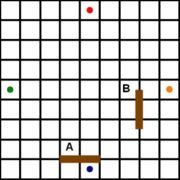
Quoridor
Encyclopedia
Quoridor is a 2- or 4-player abstract strategy game
designed by Mirko Marchesi and published by Gigamic
Games. Quoridor received the Mensa
Mind Game award in 1997 and the Game Of The Year in the USA, France, Canada and Belgium.
 Quoridor is played on a game board of 81 square spaces (9x9). Each player is represented by a pawn which begins at the center space of one edge of the board (in a two-player game, the pawns begin opposite each other). The object is to be the first player to move his/her pawn to any space on the opposite side of the gameboard from which it begins.
Quoridor is played on a game board of 81 square spaces (9x9). Each player is represented by a pawn which begins at the center space of one edge of the board (in a two-player game, the pawns begin opposite each other). The object is to be the first player to move his/her pawn to any space on the opposite side of the gameboard from which it begins.
The distinguishing characteristic of Quoridor is its twenty walls. Walls are flat two-space-wide pieces which can be placed in the groove that runs between the spaces. Walls block the path of all pawns, which must go around them. The walls are divided equally among the players at the start of the game, and once placed, cannot be moved or removed. On a turn, a player may either move his/her pawn, or, if possible, place a wall.
Pawns can be moved to an adjacent space (not diagonally), or, if adjacent to another pawn, jump over that pawn. If an adjacent pawn has a third pawn or a wall on the other side of it, the player may move to any other space adjacent to the jumped pawn which is not blocked. The official rules are ambiguous concerning the edge of the board.
Walls can be placed directly between two spaces, in any groove not already occupied by a wall. However, a wall may not be placed which cuts off the only remaining path of any pawn to the side of the board it must reach.
which was published in the 1970s. Marchesi also created another version of this game called Pinko Pallino was published in 1995 by Epta. Pinko Pallino was only for 2 players and was played on an 11×11 gameboard with a total of 42 walls and slightly different rules.
1. Quoridor rows are numbered 1 to 9, with 1 at the top and 9 at the bottom; chess rows are numbered 1 to 8, with 8 at the top and 1 on the bottom;
2. Quoridor columns are labeled a to i while chess columns are labeled a to h; and
3. Quoridor players are x and o while chess players are white and black.
Each pawn move is defined by the new square occupied by the pawn. For example, if x moves northward from square 9e to 8e, x’s move is 8e.
Each fence move is defined by the four squares within which the fence resides and by whether the fence is horizontal (H) or vertical (V). For each 2x2 set of squares, there is only one way for a horizontal fence to be placed and only one way for a vertical fence to be placed. For example, placing a vertical fence within the square formed by the intersection of rows 8 and 9 and columns d and e would be notated as V89de.
Moves are notated as they are in chess: by the move number, the x move, and the o move. For example, a typical game might start with each player moving the pawn:
1. 8e 2e
This means that for the first move of the game, x moved his pawn to 8e and o responded by moving his pawn to 2e: Each player moved his pawn one square closer to his winning row.
Note that a pawn move is always a number and a letter, and a fence move is always a V or H followed by two numbers followed by two letters. Because the notation for pawn moves and fence moves is so different, no ambiguity exists as to whether a pawn was moved or a fence was placed.
Abstract strategy game
An abstract strategy game is a strategy game, aiming to minimise luck, and without a theme. Almost all abstract strategy games will conform to the strictest definition of: a board or card game, in which there is no hidden information, no non-deterministic elements , in which two players or teams...
designed by Mirko Marchesi and published by Gigamic
Gigamic
Gigamic is a French seller of games. Their games include:* Gobblet* Pylos* Quarto* Quoridor...
Games. Quoridor received the Mensa
Mensa International
Mensa is the largest and oldest high-IQ society in the world. It is a non-profit organization open to people who score at the 98th percentile or higher on a standardised, supervised IQ or other approved intelligence test...
Mind Game award in 1997 and the Game Of The Year in the USA, France, Canada and Belgium.
Rules of the game

The distinguishing characteristic of Quoridor is its twenty walls. Walls are flat two-space-wide pieces which can be placed in the groove that runs between the spaces. Walls block the path of all pawns, which must go around them. The walls are divided equally among the players at the start of the game, and once placed, cannot be moved or removed. On a turn, a player may either move his/her pawn, or, if possible, place a wall.
Pawns can be moved to an adjacent space (not diagonally), or, if adjacent to another pawn, jump over that pawn. If an adjacent pawn has a third pawn or a wall on the other side of it, the player may move to any other space adjacent to the jumped pawn which is not blocked. The official rules are ambiguous concerning the edge of the board.
Walls can be placed directly between two spaces, in any groove not already occupied by a wall. However, a wall may not be placed which cuts off the only remaining path of any pawn to the side of the board it must reach.
History
Quoridor is also based on Mirko Marchesi's earlier game BlockadeBlockade (board game)
Blockade is a "the Beat the Barrier" board game for two players, invented by Mirko Marchesi and published by Lakeside in 1975. The newer strategy game Quoridor shares many of the same characteristics as Blockade.-Gameplay and rules:...
which was published in the 1970s. Marchesi also created another version of this game called Pinko Pallino was published in 1995 by Epta. Pinko Pallino was only for 2 players and was played on an 11×11 gameboard with a total of 42 walls and slightly different rules.
Notation
The squares of the 9x9 board are labeled like a spreadsheet: Rows are numbered 1 through 9 from top to bottom; and columns are labeled a through i from left to right. Quoridor square labels are similar to that of chess. In fact they are identical except for these differences:1. Quoridor rows are numbered 1 to 9, with 1 at the top and 9 at the bottom; chess rows are numbered 1 to 8, with 8 at the top and 1 on the bottom;
2. Quoridor columns are labeled a to i while chess columns are labeled a to h; and
3. Quoridor players are x and o while chess players are white and black.
Each pawn move is defined by the new square occupied by the pawn. For example, if x moves northward from square 9e to 8e, x’s move is 8e.
Each fence move is defined by the four squares within which the fence resides and by whether the fence is horizontal (H) or vertical (V). For each 2x2 set of squares, there is only one way for a horizontal fence to be placed and only one way for a vertical fence to be placed. For example, placing a vertical fence within the square formed by the intersection of rows 8 and 9 and columns d and e would be notated as V89de.
Moves are notated as they are in chess: by the move number, the x move, and the o move. For example, a typical game might start with each player moving the pawn:
1. 8e 2e
This means that for the first move of the game, x moved his pawn to 8e and o responded by moving his pawn to 2e: Each player moved his pawn one square closer to his winning row.
Note that a pawn move is always a number and a letter, and a fence move is always a V or H followed by two numbers followed by two letters. Because the notation for pawn moves and fence moves is so different, no ambiguity exists as to whether a pawn was moved or a fence was placed.
Strategies
- Reed opening: This opening consists in placing, during the first two moves of the game, two walls on the third row in front of the opponent with a single gap in the middle. This opening is attributed to Dr. Scott Reed (Edinburgh, UK), a known military strategist and frequent player. A counter-strategy to the Reed opening is to place two horizontal walls on the third row, one at the extreme left and one at the extreme right, which effectively reduces both players' path counts to one: 1.H34cd H34ab 2.H34fg H34hi
- Shiller opening: Players x and o advance their pawns three times each (1.8e 2e 2.7e 3e 3.6e 4e). Then x places one wall vertically at the bottom of x's board (at V89cd, V89de, V89ef, or V89fg), providing two paths for o to win while maintaining just one path for x. The Shiller opening implements the strategy of maximizing the opponent's path count and of minimizing one's own path count. Larry Shiller (Wilton, CT) is a known math educator, software author and consultant, and author of an upcoming book on Quoridor strategy.
External links
- Java implementation, including computer opponent
- Flash implementation Play vs. computer or other players free online
- C++ using SDL implementation, open source solution

